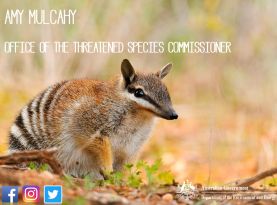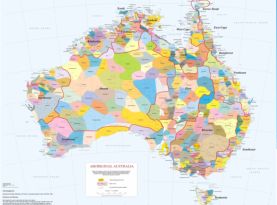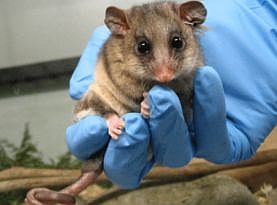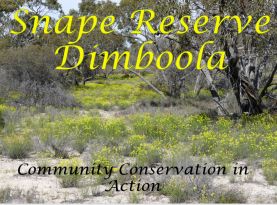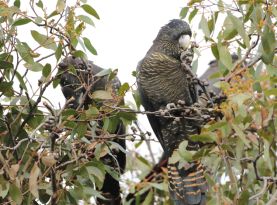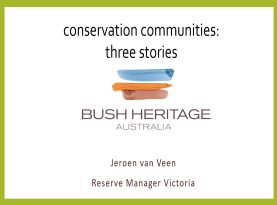SWIFFT Seminar notes 24 October 2019
Community conservation in action
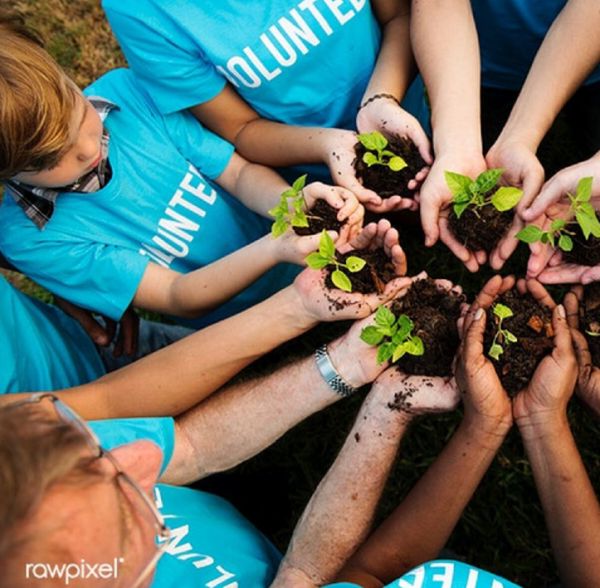
SWIFFT seminar notes are a summary of the seminar and not intended to be a definitive record of presentations made and issues discussed.
This SWIFFT seminar was conducted via Zoom and supported through resources and technology provided by the Department of Environment, Land, Water and Planning, Victoria. SWIFFT wishes to thank speakers for their time and delivery of presentations. Thanks to Michelle Butler who chaired the session from DELWP, Ballarat.
Key points summary
Community engagement ensuring conservation outcomes
- Australia has over 1800 Nationally Listed species.
- Australia’s first Threatened species Commissioner was appointed in 2014.
-
The Australian Government Threatened Species Strategy is the guiding policy document on protecting threatened species and averting extinction.
-
Soloutions are more meaningful and enduring if they are tailored for local circumstances and involve local communities.
Cultural Protocols, Threatened Species and Traditional Knowledge
- Traditional knowledge passed down through the generations can play a part in western science to better understand species conservation.
-
A recognition of diversity between Nations is important when dealing with Aboriginal communities.
-
The Threatened Species Hub has an Indigenous component driven by an Indigenous Engagement & Participation Strategy.
-
Indigenous Engagement Cultural Protocols are being developed.
Bogong Moth Tracker & the Mountain Pygmy Possum
- There are only about 2000 Mountain Pygmy Possums remaining in the wild.
- Zoos Victoria commenced a Mountain Pygmy Possum captive breeding program in 2017.
-
Mountain Pygmy Possums feed on Bogong Moths in September-October. In 2017 & 2018 Mountain Pygmy Possum breeding in the wild was very poor due to a crash in the numbers of Bogong Moths migrating to Alpine areas.
-
Moth Tracker enables the community to record Bogong moth migration.
Restoring biodiversity in the Wimmera, Snape Reserve Committee of Management
- Restoration of the reserve and its native flora and fauna is a credit to the Committee, Trust for Nature and hours of work that members have put in since 2003.
-
The reserve supports about 176 species of birds and a number of threatened species of fauna and flora.
Increasing critical food supply for the endangered South-eastern Red-tailed Black Cockatoo
- Stringybark seed is one of the main sources of food for the South-eastern Red-tailed Black Cockatoo.
-
There is a failure of recruitment of this species across landscapes, both in natural and revegetation areas where the cockatoos occur. Lack of canopy protection being identified as the main cause for recruitment failure.
-
New methods for planting revegetation areas and management of natural areas are being developed.
Bush Heritage priority landscape Kara Kara to Wedderburn
-
In Victoria, Bush Heritage Australia focuses on the landscape near Wedderburn, containing grassy woodland systems north of the Great Dividing Range.
-
Bush Heritage projects involves bringing community interests and partner organisations such as Trust for Nature together to achieve conservation goals.
-
Projects include; Mt Korong Eco-watch (private and public land), Nardoo Hills land purchases for conservation and Wedderburn Conservation Management Network .
-
Community participation and volunteer support is essential for landscape conservation outcomes.
List of speakers and topics
-
Community engagement ensuring conservation outcomes - Amy Mulchy, Communications Manager, Office of the Threatened Species Commissioner Department of Environment & Energy, Canberra.
-
Cultural Protocols, Threatened Species and Traditional Knowledge - Bradley J. Moggridge, PhD Candidate UC (full time), Indigenous Liaison Officer – Threatened Species Recovery Hub under NESP (part time).
-
Bogong Moth Tracker & the Mountain Pygmy Possum - Darcie Carruthers, Conservation campaigner - Zoos Victoria.
-
Restoring biodiversity in the Wimmera - Lindsay Smith, Chairman of Snape Reserve Committee of Management.
-
Increasing critical food supply for the endangered South-eastern Red-tailed Black Cockatoo - Jess Gardner-Greening Australia.
-
Conservation communities: three stories - Jeroen van Veen, Bush Heritage Australia, Reserve Manager Victoria.
SPEAKER SUMMARIES
Community engagement ensuring conservation outcomes
Amy Mulchy, Communications Manager, Office of the Threatened Species Commissioner Department of Environment & Energy, Canberra.
Overview of the Threatened species Commissioner role
Australia’s first Threatened species Commissioner was appointed in 2014 to help give threatened species the policy priorities they deserve and bring a renewed focus to threatened species in the Australian Government. The role involves raising awareness of threatened species and threats they face and to implement policy, mobilising resources both within and outside of Government.
The current Commissioner is Dr Sally Box who commenced her role in January 2018. There are 8 staff who work in policy co-ordination and outreach roles within the Biodiversity Conservation Division of the Department of Environment & Energy, Canberra.
Australian Government Threatened Species Strategy
The Threatened species strategy was launched in 2014 and will be revised in 2020. It is the guiding policy document on protecting threatened species and averting extinction. Amy pointed out that solutions are more meaningful and enduring if they are tailored for local circumstances and involve local communities.
Examples of National and local conservation
Blue Top Sun-orchid Thelymitra cyanapicata (Critically endangered).
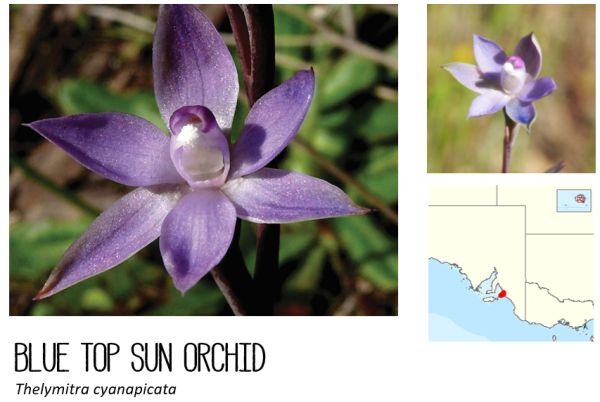
As part of the Australian Government Threatened species recovery fund a project involving the Royal Botanic Gardens, Victoria is aiming to produce 400 Blue Top Sun-orchids with a significant volunteer effort from members of the Australasian Native Orchid Society. Amy emphasised the importance of on-going monitoring and post translocation maintenance which involves skilled volunteers.
Whibleys Wattle Acacia whibleyana (Endangered). This species is endemic to the Tumby Bay Region, South Australia with only about 200 plants thought to be remaining in the wild. It is one of 30 plants targeted for recovery by 2020 under the Australian Government Threatened species strategy. The project has close involvement with the local community though surveys and propagation, planting and management. Though surveys supported by the local community a further 891 plants have been found.
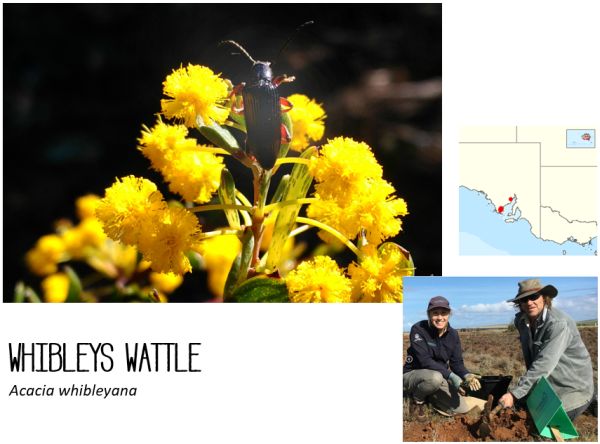
Malleefowl Leipoa ocellate (Endangered)
Amy discussed threatened species recovery involving a species with an extensive range. The project has a co-ordinated army of volunteers and professionals involved with monitoring and management activities. It has a strong multi-jurisdictional recovery team and one of the best long running monitoring efforts of any species in Australia with over 3500 mounds being monitored each year.
Raising awareness about threatened species
Amy spoke about the fact that Australia has over 1800 Nationally Listed species but few Australians know about how many of our plants and animals are threatened.
The Threatened species Commissioner’s Office often engages communities through awareness via;
- Direct community engagement
- Social and traditional media
- Novel raising awareness
Examples:
Social media ‘Threatened Species Day-Bake Off’ where the Australian public are invited to bake a threatened species themed desert to raise awareness for Threatened species Day. Over 300 entries were received from across Australia. Entries indicated the event reached a new audience with over 600K people viewing the social media sites.
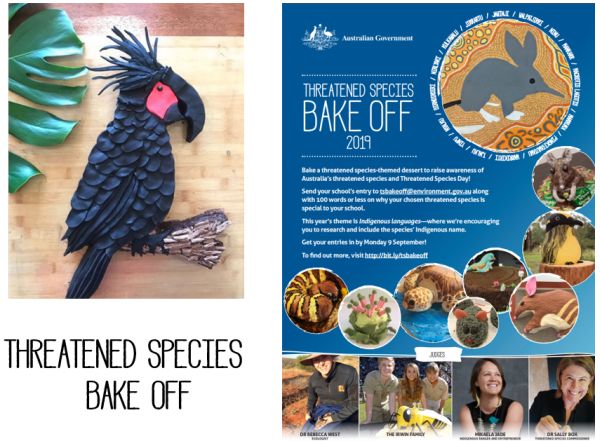
Amy spoke about the use of social media to raise awareness regarding the impacts from feral and domestic cats. She explained it was easy to see how many people viewed the posts but measuring rate of behavioural change was more difficult. Amy is currently seeking to use resource within DEE to evaluate the impact of communications and the effectiveness of behavioural change.
Key points from questions
- The Threatened Species Strategy only targets Birds, Mammals and Plants and some targeted actions e.g. feral cats. When the strategy is revised in 2020 it is possible that a new Strategy would include other taxa.
- Social media surveys and polling can be used to gauge participation.
Cultural Protocols, Threatened Species and Traditional Knowledge
Bradley J. Moggridge, PhD Candidate UC (full time), Indigenous Liaison Officer – Threatened Species Recovery Hub under NESP (part time).
Bradley introduced his talk by acknowledging the Traditional owners of the land. He spoke about his strong connection to water, particularly Kamilaroi country and Boobera Lagoon in north-western NSW.
Diversity
Bradley spoke about the diversity of Indigenous Nations across Australia, for example over 250 languages are recognised along with a variety of other social and cultural factors which are relevant to each Nation. A recognition of diversity between Nations is important when dealing with communities.
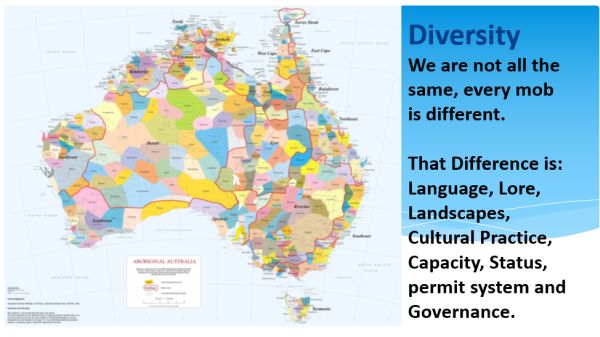
Brief history
Bradley spoke about his timeline which highlights significant periods and influences on Aboriginal culture since 58,212 BC, then discovery by Cook in 1770 and the arrival of the first fleet in 1788. Assimilation (breed the black out), Aborigines Protection Board, White Australia Policy, Missions and Reserves, 1967 Referendum (the year before he was born), Mabo Decision (Native Title), Bringing Them Home Report, Sorry, Uluru Statement.
Culture, Protocols and Safety
The concept of culture is important for Bradley, knowing who he is and his mob, respecting elders, learning and speaking language and the relationships with kin all build culture along with connection to country. For Bradley, connection to the water place and the species in that place and stories all form part of his culture.
Bradley spoke about a number of protocols and key principles which he uses for getting the best engagement;
- Employment of Aboriginal people in projects.
- Reciprocity – meaning the need giving something back to the mob rather than just take away knowledge and use up people’s time.
- Identify local protocols – understanding the diversity of Nations and ways of doing things can be different.
- Identify the key people for engagement which can take time to establish.
- Get to know the mob and allow them to Welcome you to their Country.
- Seek all the relevant approvals.
- Take time to earn trust and always be genuine.
Cultural safety is important when engaging communities, ensuring everyone is safe and comfortable in their surroundings. It is also important to follow local protocols and approvals. Getting the right people in attendance may take time. Speaking in plain language and not being overly scientific requires consideration depending on who is attending. Listening is vitally important and sometimes involves hearing about unrelated issues.
David spoke about a number of potential barriers when dealing with indigenous communities which can be avoided if the above protocols and principles are built into discussions and enough time is taken to build trust and an understanding of the community’s needs.
Traditional Ecological Knowledge (TEK)
First Peoples (Indigenous people) have inhabited Australia for thousands of generations, the traditional knowledge passed down through the generations can play a part in western science to better understand species conservation including identified threatened species, culturally significant species and indicator species which reflect seasonal patterns and landscape health.
David pointed out that some listed Threatened species may not be culturally significant and cultural species may not be threatened species. Also some threatened species may be tasty and considered a food resource.
Whilst threatened species occur across a wide variety of landscapes they also occur on Aboriginal owned lands which comprise nearly half of Australia’s protected area estate. The Indigenous ranger programs is only 6% of the conservation estate budget.
Threatened Species Recovery Hub
David discussed his involvement with the Hub and the opportunities to input traditional knowledge into the species recovery process. The Hub’s Indigenous component is driven by Indigenous Engagement & Participation Strategy (IEPS). David is also working on developing Indigenous Engagement Cultural Protocols. David pointed out that the retention of intellectual property is a key factor for partners in the program.
The Hub operates with a 5-person Indigenous Reference Group. At this stage the current Threatened Species Recovery Hub will conclude in 2021.
Some of the highlights from David’s work include;
- Indigenous researcher for the Arid Zone Monitoring Project – Prof. Sarah Legge.
- Indigenous researcher 2019 to work with RMIT on the Iconic Species in Schools Project – Prof. Sarah Bekessy.
David also considers one of his highlights to be submitting and defending a submission to the Threatened Species Senate Inquiry.
David highlighted two publications which flowed from work at the Hub, plus a special edition of Science for Saving Species which features Indigenous partnerships.
Publications
- Leiper, I., K.K. Zander, C.J. Robinson, J. Carwadine, B.J. Moggridge & S.T. Garnett (2018) Quantifying current and potential contributions of Australian Indigenous peoples to Threatened species management. Journal of Conservation Biology. https://onlinelibrary.wiley.com/doi/abs/10.1111/cobi.13178
- Indigenous submission for the Senate Inquiry into Australia’s Faunal Extinction Crisis. Australia’s faunal extinction crisis - Submission 159 - Attachment 7
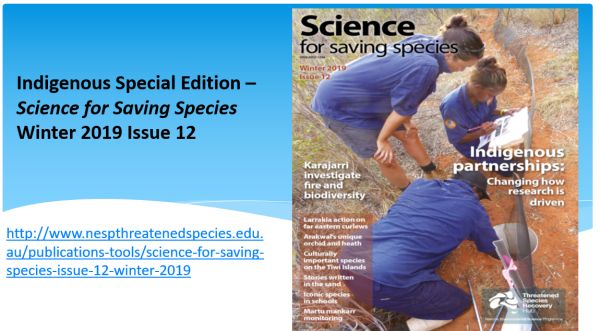
Contact: Bradley J. Moggridge, Threatened Species Recovery Hub
Contact: Bradley J. Moggridge, Water related studies
Key points from questions
- The idea of recognising culturally significant species is very worthwhile and could be raised in a submission to the EPBC Act review.
Bogong Moth Tracker & the Mountain Pygmy Possum
Darcie Carruthers, Conservation campaigner - Zoos Victoria
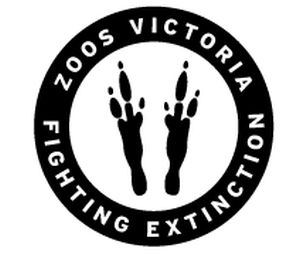
Fighting Extinction
Darcie provided an overview of Zoos Victoria Fighting Extinction which focuses on 27 priority threatened species with a pledge that no Victorian vertebrate threatened species will go extinct on Zoos Victoria watch.
Zoos Victoria works with a large number of partners across Community Conservation (social campaigns) and Threatened species conservation (Biological).
More details: SWIFFT seminar February 2019
Community conservation campaigns
Darcie spoke about some of Zoos Victoria campaigns e.g. Seal the Loop (approx. 70 km of fishing line disposed), Don’t Palm it Off (460,000 people standing up for transparent Palm Oil labeling), When balloons fly Seabirds die (200,00 people have pledged to replace balloons with wildlife friendly alternatives).
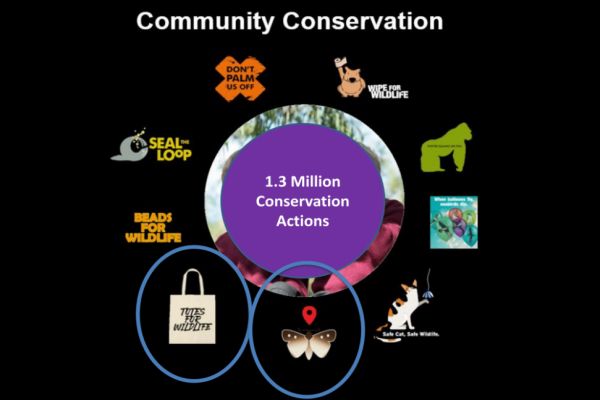
Mountain Pygmy Possum (Critically endangered)
The Mountain Pygmy Possum is Australia’s only hibernating mammal. Hibernation last up to 7 months of the year. Males have a short life span, sometimes only one year. There are only about 2000 individuals remaining in the wild at two main locations in the Alpine environment. Connectivity is a major issue, particularly as development in Alpine areas (roads, ski fields etc.) makes it difficult for females which inhabit higher altitudes to interact with males which live further down the mountain.
Captive breeding
In 2007, Zoos Victoria commenced a Mountain Pygmy Possum captive breeding program which has since produced over 100 Mountain Pygmy Possums. Displays are set up at Healesville Sanctuary and Werribee Open Range Zoo.
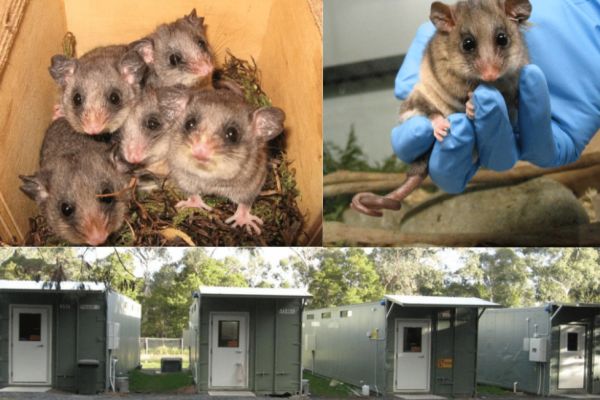
Why are Mountain Pygmy Possums starving in the wild?
When Mountain Pygmy Possum emerge from hibernation during Spring they have lost a significant body weight and need to feed and restore body weight in time for the Spring breeding season (September – October) which is also the time of the year when millions of protein rich Bogong Moths migrate to Alpine areas. The moths provide a rich and plentiful source of food for the Mountain Pygmy Possums.
In 2017, it was noticed that Bogong Moth numbers crashed from an estimated 4.4 billion moths migrating to the Alpine zone to just a handful. The Spring of 2018 yielded a similar situation to 2017 with a lack of moths for Mountain Pygmy Possums to feed on. This resulted in;
- 25% population decrease at Mt Loch (NSW)
- 95% litter loss at Mt Loch (NSW)
- At least 50% litter loss at all monitored Victorian sites
- Females underweight
- Necropsy of a number of failed litters found nothing in digestive tract – starvation
Bogong Moth Migration
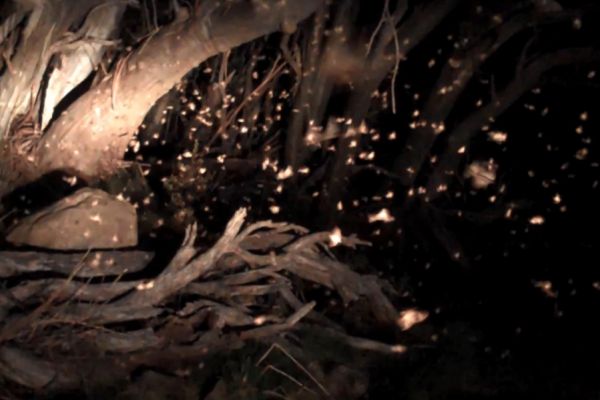
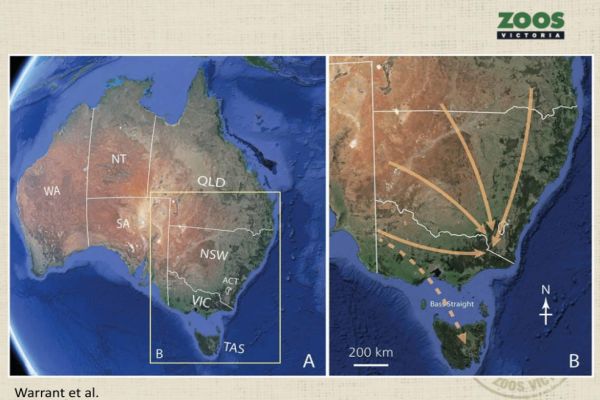
Darcie pointed out that some of the reasons for the low numbers of moths arriving in the Alpine zone could be due to drought in the moth’s breeding grounds, pesticides and an ever-expanding issue of light pollution which diverts moths from their normal flight path.
2019 moth migration
In order to understand moth migration into the Alpine zone Zoos Victoria in conjunction with SWIFFT has set up a special Moth Tracker site which enables the community to record Bogong Moth migration.
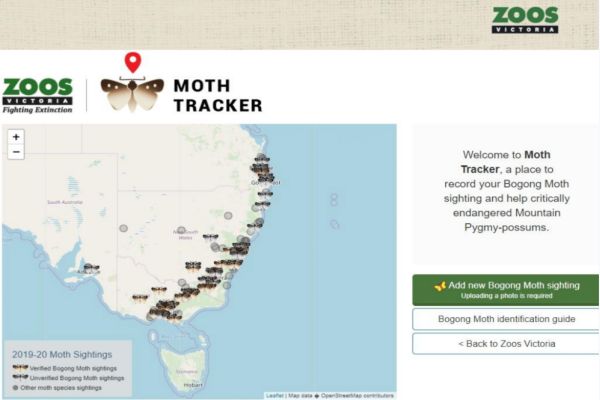
Since Moth Tracker was launched on 15 September 2019 there has been a massive community input (Landcare groups, Community groups, other conservation organizations, Traditional owners, Youth and education sector, the scientific community and general community). Most of the records submitted were of single moths but fortunately in mid-October 2019 some significant swarms were located at Mt Hotham. Darcie pointed out this is Citizen Science at its best and thanked everyone who has been involved.
Light pollution
Darcie spoke about the need to reduce light pollution along the Bogong Moth flight path as they can distract and trap the moths from completing their migration which they have done for at least the last 7 thousand years. A call to action has gone out to those in the moth's flight path, relevant councils, managers of large, brightly lit buildings and monuments to turn unnecessary lights out.
Totes for Wildlife
This project is focused in Victoria and operates on the basis that when a person buys a tote bag, Zoos Victoria will plant a tree for a wild Mountain Pygmy Possum. The trees selected are species that provide a food source e.g. Alpine Plumb-pine Podocarpus lawrencei.
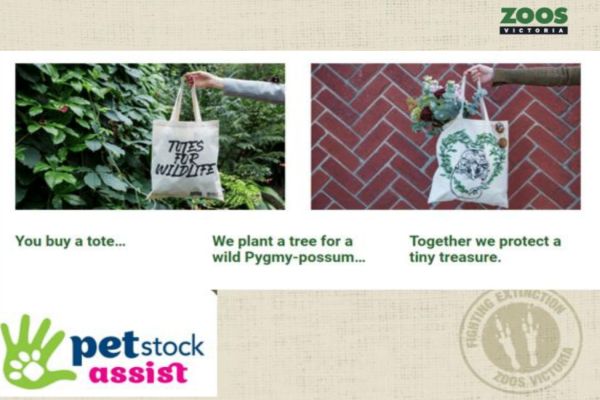
One month since the campaign launch 6,000 Mountain Pygmy Possum tote bags have been sold across the three Zoos Victoria properties, which equates to 6,000 new trees for the Mountain Pygmy Possum and an opportunity to engage the community in understanding more about their conservation and the Moth Tracker.
Key points from questions
‘Lights off for the Bogong Moths’ has been a challenging initiative to implement but light pollution has consistently been raised an issue, particularly around Canberra which is on the moth’s flight path. Work was done using satellites to identify any light pollution hot spots so priority sites could be targeted (major public buildings, monuments etc.) so realistic monitoring could be carried out. This concept will be developed for the 2020 migration.
Zoos Victoria - Fighting Extinction, Mountain Pygmy Possum
Totes for Wildlife - Zoos Victoria
Restoring biodiversity in the Wimmera - Snape Reserve Committee of Management
Lindsay Smith, Chairman of Snape Reserve Committee of Management
Snape Reserve is 342 ha. (846 acres) located on the north-east corner of the Little Desert National Park, 4 km west of Dimboola, Victoria. The area is owned by Trust for Nature and managed by the Snape Reserve Committee of Management which was formed in 2003. The area has an agricultural history in parts with land clearing in 1985 for cropping, some areas remained intact. Cleared areas have been the focus of a tremendous amount of weed and rabbit control which paved the way for revegetation.
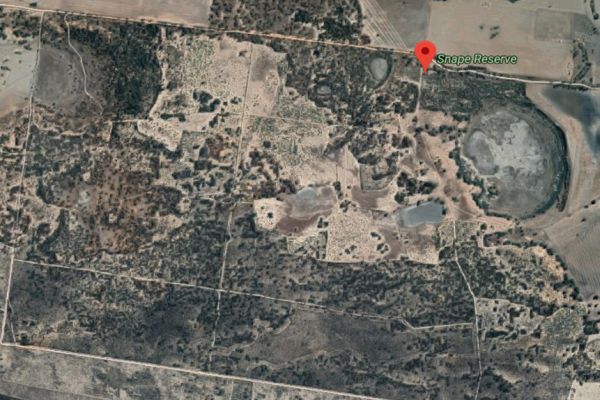
Lindsay spoke about the impacts of the drought over the last 10 years with drying out of the country. Fortunately, in 2011 there was good rain which supported many waterbirds for a period of time.
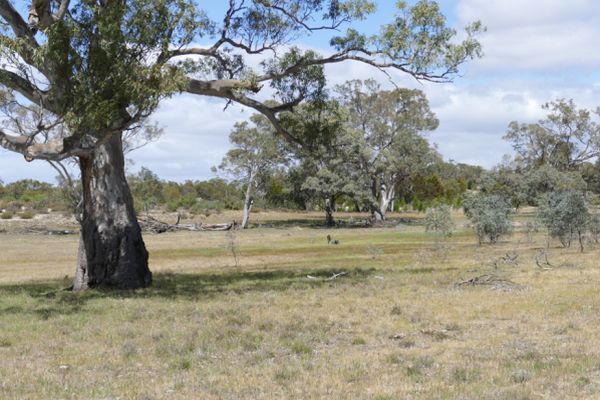
Remnant Red Gums provide a valuable basis for restoring the landscape. The reserve now supports about 176 species of birds.
Significant species
Lindsay provided an overview of some of the significant species.
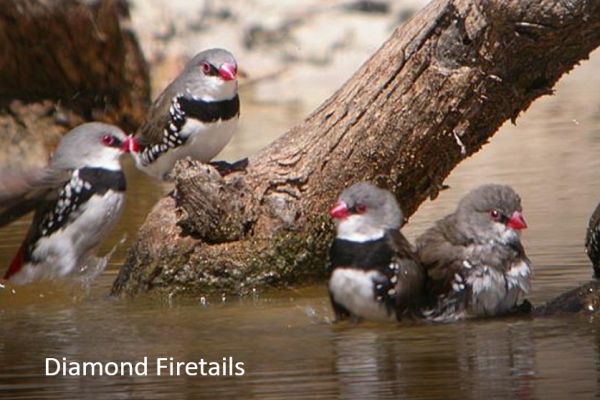
- Red-tailed Black Cockatoos (endangered) have been recorded in the reserve 9 times over 17 years mainly May to July.
- Silky Mouse (near threatened) inhabits the intact areas in the southern part of the reserve.
- Sand Monitors (not threatened) and Lace Monitors (endangered) breeding in the reserve, for this reason no fox baiting is carried out.
- Wimmera Woodruff Asperula wimmerana (rare) is found in the swampy areas on the reserve. This plant has suffered a decline across the Wimmera due to the fact that it once occurred on good country for cropping.
- Winged Peppercress Lepideum monoplocoides Nationally endangered, has self-seeded in the wetter parts of the reserve.
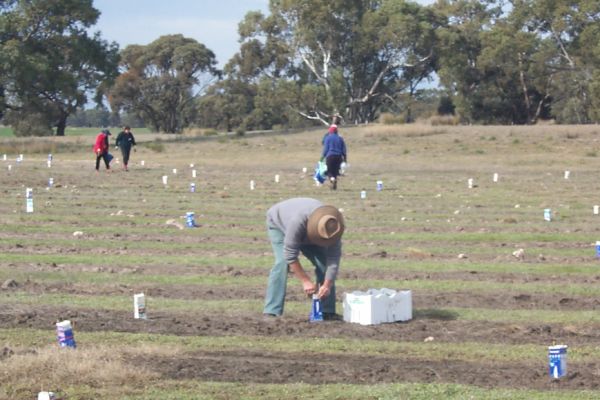
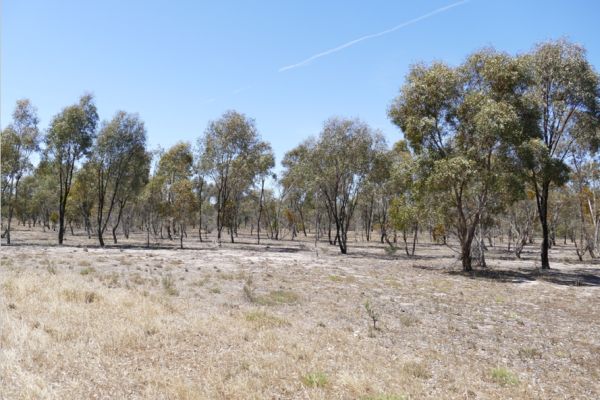
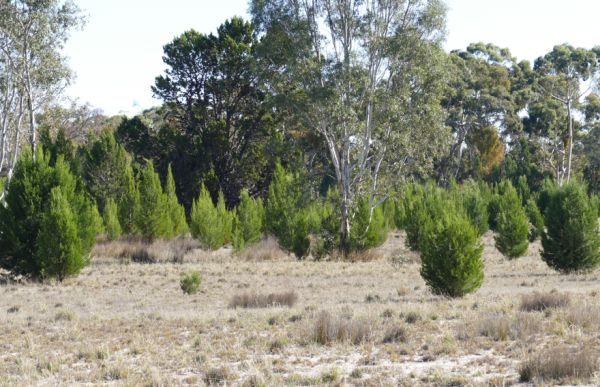
On-going weed control and ripping of rabbit burrows is undertaken which is all proving very successful in restoring the landscape both through planting and natural regeneration. There are about 60 kangaroos on the property which Lindsay calls the fire department because they keep fuel levels down in grassy areas.
Snape Reserve is open to the public. There is an information bay which describes the Aboriginal history and recent history of management. There is also information about Trust for Nature. Visitors are asked to donate a gold coin to assist with on-going management.
More information: Snape Reserve
Restoration of the reserve and its native flora and fauna is a credit to the Committee, Trust for Nature and the hours of work that members have put in since 2003.
Increasing critical food supply for the endangered South-eastern Red-tailed Black Cockatoo
Jess Gardner - Greening Australia
This project is funded by DELWP, Biodiversity Response Plan, which involves a partnership between Trust for Nature (TFN) and private land conservation – Snape Reserve Committee. The aim is to plant 30,000 Stringybarks in degraded private land remnants which were cleared in the past but are now under TFN covenants. These areas are ideal because they are managed primarily for conservation and have already had a great deal of weed control carried out which has resulted in areas of natural regeneration.
.jpg)
What’s going on with the Stringybarks?
Stringybark seed is one of the main sources of food for the South-eastern Red-tailed Black Cockatoo the but there is concern regarding a failure of recruitment of this species across landscapes where the cockatoos occur. Stringybarks are not well represented in National Parks, they are mostly found on Crown Land or State Forest and are frequently targeted for burning which is a problem, if burns are too hot there is simply no germination which results in a lack of age diversity. It can take 15-20 years for a canopy to recover.
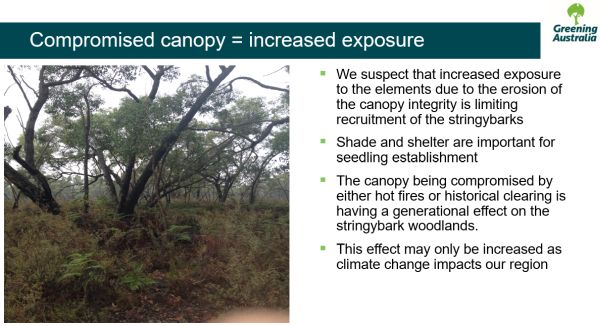
In revegetation areas where direct seeding is used there has been good germination but the trees do not make it past the first summer. Low soil moisture and high soil temperatures being identified as the main reasons for loss. During Winter, fungal damage and frost damage have resulted in poor survival of seedlings. Overall the Summer and Winter issues are related to lack of canopy protection.
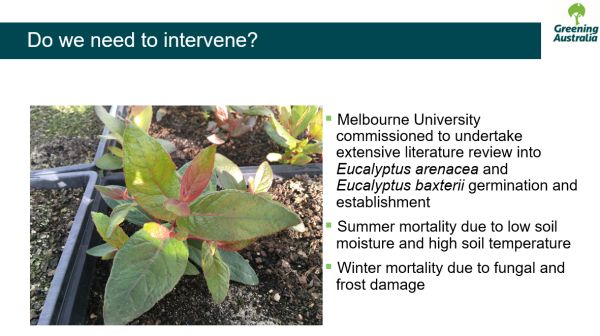
Adapting to achieve better outcomes
Planting within remnants to occur on the south side of something which provides afternoon shade.
Early as possible planting season with addition of fertiliser tablets to maximise growth before summer.
Consideration of later infill inclusion of stringybarks into revegetation sites once established to ensure shade and shelter.
Key points from questions
- Due to the scale of the project contract labor is being used to undertake much of the planting which creates paid employment for local people.
Contact: Jess Gardner, 0437 958 259
More about South-eastern Red-tailed Black-cockatoo on SWIFFT
Conservation communities: three stories
Jeroen van Veen, Bush Heritage Australia, Reserve Manager Victoria
Jeroen provided a brief overview of Bush Heritage Australia which started in the early 90’s. There are now a number of priority landscapes across Australia where Bush Heritage operates. These were identified as landscapes under threat with the least amount of conservation action so Bush Heritage can make a big impact with the least amount of investment.
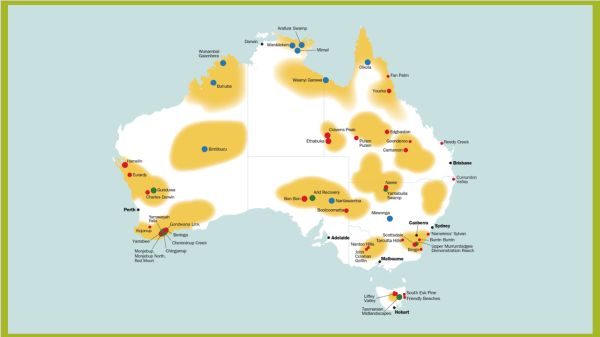
In Victoria, a landscape near Wedderburn was identified, containing grassy woodland systems north of the Great Dividing Range. It is an area with a lack of National Parks which would benefit from linking the landscape to create a functioning healthy system.
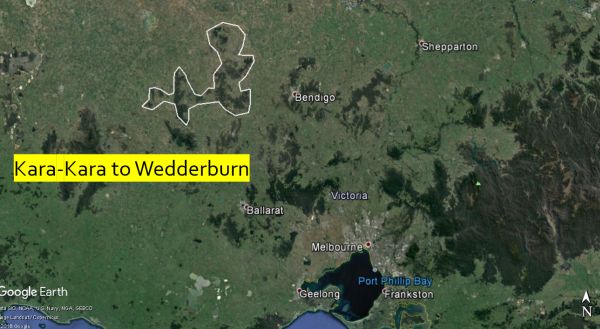
Story 1. Mt Korong- Korong Ridge
This project involved land purchase by a partner organization using carbon credits and native vegetation offsets to purchase land adjacent to the Mt Korong Nature Conservation Reserve. The land was mainly grazing and cropping which could be used for carbon offsets but also contained some high-quality remnants which were used as vegetation offsets. The titles were consolidated into ten 100 & 150 ha blocks and the whole area covenanted to Trust for Nature. After all the remedial actions were completed such as revegetation weed and pest control the blocks were sold off as covenanted blocks. The new landholders, all conservation minded people worked with Bush Heritage to remove internal fences and manage the area as a whole, a new conservation group called Mt Korong Eco-watch was formed to manage the land for conservation. Mt Korong Eco-watch
The Mt Korong Eco-watch project has attracted interest from some other landholders in the area who have joined in on the landscape conservation effort.
Story 2. Bush Heritage and Nardoo Hills
Bush Heritage has been purchasing land in the Nardoo Hills over a number of years. The total area for conservation is now 12,000 ha. Jeroen spoke about a volunteer weeding program which has been running since 2006, which runs for a whole weekend once per month during the winter. People stay in Wedderburn and accommodation costs met by BH. About 200 people have volunteered and many people return again and again, their efforts contributing to restoration of the landscape.
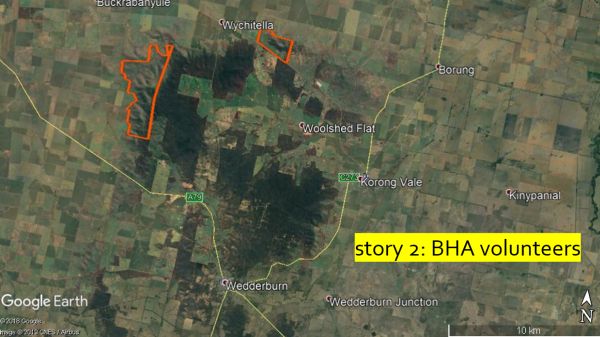
Volunteers are contributing to landscape restoration on Bush Heritage land at Nardoo Hill.
Story 3. Wedderburn Conservation Management Network (CMN)
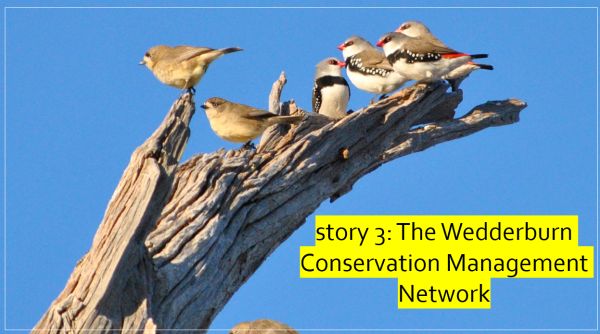
The network commenced in 2003 and has a diverse membership from landholders, farmers, Landcare, conservationists, government, NGO’s etc. Jeroen pointed out that existence of a CMN was a contributing factor which helped Bush Heritage to be involved in the Wedderburn area.
Over the years there has been less government involvement to help support the CMN, with loss of facilitators and more demands on community members it has been difficult to maintain momentum and attract renewal through new members. Jeroen felt a renewed level of support from the government sector would help the network to sustain the good conservation work they have achieved over the years.
Bush Heritage Australia volunteer opportunities
View notes from previous SWIFFT Seminars
Previous SWIFFT Seminars with Indigenous Cultural themes
- Cultural Protocols, Threatened Species and Traditional Knowledge
- Two ways of knowing natural temperate grasslands of the Victorian Volcanic Plain
- Returning Dja Dja Wurrung to the landscape
- Gunditjmara fish, mussels & crayfish
- Indigenous knowledge of ecology
- Indigenous Fire Workshop, Cape York
- Aboriginal waterway assessments
- Barapa Barapa Water for Country project


